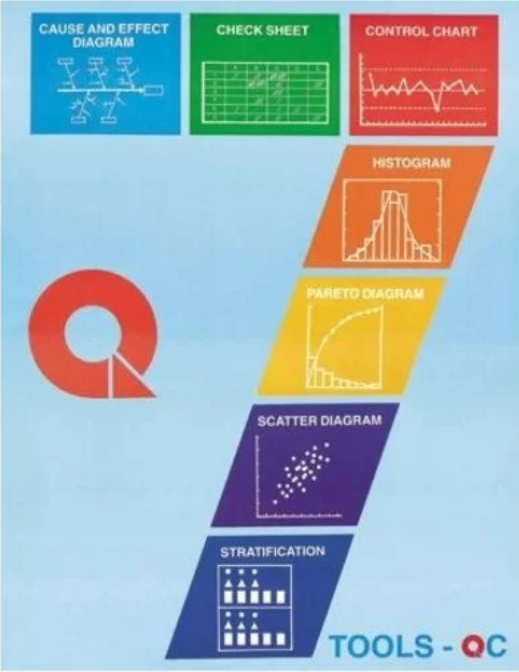7 QC Tools Training 
The 7 QC Tools are essential tools that help businesses identify, analyze, and effectively address quality-related issues. From increasing process effectiveness to decreasing defects, these tools give organizations the power to consistently enhance and deliver top-notch products and services. At Swades QMS, we strive to help organizations reach greatness in their quality management endeavors. As an industry leader, we provide intensive training sessions, including our extremely popular 7 QC Tools Training. Our program furnishes learners with the knowledge, capabilities, and practical insights needed to make these tools work effectively in their sector.
Our Training Methodology
We follow a dynamic training methodology that focuses on active participation, experiential learning, and knowledge application. Our experienced trainers employ a variety of techniques to create a stimulating and immersive training environment.
Interactive and Practical Sessions:
Our training sessions are far from passive lectures. We foster an atmosphere of collaboration and engagement, encouraging participants to actively contribute and learn from one another. Through group discussions, workshops, and hands-on exercises, participants gain practical experience in using the 7 QC Tools.
Hands-On Exercises, Case Studies, and Real-World Examples:
We firmly believe in learning by doing. Our training program incorporates hands-on exercises that simulate real-life quality scenarios, allowing participants to practice applying the 7 QC Tools in a controlled environment. We also utilize relevant case studies and real-world examples to illustrate the application of these tools across different industries.
Industry Best Practices and Relevant Standards:
Our training is grounded in industry best practices and the latest quality management standards. We provide insights into how the 7 QC Tools align with internationally recognized quality frameworks, such as ISO 9001. By integrating these practices and standards into the training, participants gain a comprehensive understanding of how the tools can be effectively utilized within their organization.
Training Content
1. Introduction to Quality Control and the 7 QC Tools
- Overview of quality control principles and importance in organizations
- Introduction to the concept of the 7 QC Tools and their significance
- Explanation of how the 7 QC Tools contribute to quality improvement initiatives
2. Pareto Chart
- Understanding the Pareto principle and its application in quality control
- Steps to create a Pareto chart for identifying and prioritizing quality issues
- Analyzing and interpreting Pareto charts to focus improvement efforts
3. Cause-and-Effect Diagram (Fishbone Diagram)
- Introduction to cause-and-effect diagrams and their purpose in problem-solving
- Steps to construct a cause-and-effect diagram to identify root causes
- Using the fishbone diagram to facilitate team brainstorming and analysis
4. Check Sheet
- Understanding the purpose and benefits of check sheets in data collection
- Designing and utilizing check sheets for collecting quality-related data
- Analyzing check sheet data to identify trends, patterns, and areas for improvement
5. Scatter Diagram
- Introduction to scatter diagrams and their role in analyzing relationships between variables
- Creating scatter diagrams to visualize correlations and potential cause-and-effect relationships
- Interpreting scatter diagrams and making data-driven decisions based on the analysis
6. Histogram
- Explanation of histograms and their application in data analysis
- Constructing histograms to understand distribution patterns and variations
- Interpreting histograms to identify process performance and areas for improvement
7. Control Chart
- Overview of control charts and their significance in monitoring process stability
- Steps to create and interpret control charts for tracking process performance
- Utilizing control charts to identify and respond to process variations and out-of-control situations
8. Scatter Diagram
- Introduction to scatter diagrams and their role in analyzing relationships between variables
- Creating scatter diagrams to visualize correlations and potential cause-and-effect relationships
- Interpreting scatter diagrams and making data-driven decisions based on the analysis
9. Data Collection and Analysis Techniques
- Best practices for effective data collection and management
- Techniques for analyzing and interpreting data using the 7 QC Tools
- Integrating the 7 QC Tools into a comprehensive quality control system
10. Application and Case Studies
- Applying the 7 QC Tools to real-world quality issues and challenges
- Analyzing case studies to understand practical implementation of the tools
- Discussion and sharing of success stories and lessons learned
11. Q&A and Wrap-Up
- Addressing participant questions and concerns
- Summarizing key takeaways from the training program
- Closing remarks and next steps for participants to apply the acquired knowledge
Who Should Attend
- Managers, Executives, Engineers and Other Staff
- Students or any Professionals requiring an overview of 7 QC Tools

